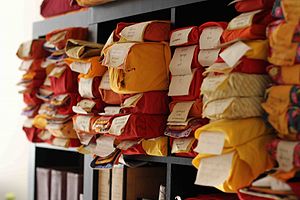Tibetan Buddhist Canon
| Tibetan canon |
|---|
| Mainstream texts |
| Mahayana sutras |
| Tantras |
The Tibetan Buddhist Canon refers to the core texts of Tibetan Buddhism. The canon is divided into two branches:
- Kangyur (Wylie: bka'-'gyur) or "translated words", contains sutras and tantras, which are considered "the word of the Buddha" in the Tibetan tradition.
- Tengyur (Wylie: bstan-'gyur) or "translated treatises", contains works written by Indian Buddhist masters that explain and elaborate on the words of the Buddha.
The Tibetan Buddhist Canon consists primarily of works that were translated from Indian languages (mainly Sanksrit) into Tibetan between the 7th and 14th centuries (during the later stages of Indian Buddhism). The canon also includes works that were translated from Chinese and Central Asian languages.[1]
This canon is one of the three major Buddhist Canons, the other two being the Chinese Buddhist Canon, and the Pali Canon.[2]
Contents
Kangyur

The Kangyur contains sutras and tantras, which are considered "the word of the Buddha" in the Tibetan tradition.
Generally, the main categories of the Kangyur are:[3][4]
- Vinaya (dealing with monastic discipline, etc.)
- Sutras
- Prajñaparamita (the "Perfection of Wisdom”)
- Avatamsaka (the “Flower-Ornament”)
- Ratnakuta (the “Heap of Jewels”)
- General Sutra Section (a collection of 266 sūtras, containing both Mahayana and Sravakayana sutras)
- Thirteen late translated sutras (a group of Theravada sutras)
- Tantras
- Tantra (a collection of 468 tantras, mainly from the "later translation period")
- Nyingma Tantra (seventeen tantras from the "early translation period")
- Kalachakra (the “Wheel of Time”)
- Dharani (collection of dharanis)
Tengyur

The Tengyur contains works written by Indian Buddhist masters that explain and elaborate on the words of the Buddha.
Generally, the main categories of the Tengyur are:[3]
- Praises
- Tantra (Vajrayana treatises)
- Prajñaparamita (treatises on the “transcendent perfection of wisdom”)
- Madhyamaka (treatises based on Nagarjuna’s “middle way” philosophy)
- Sutra-commentary (general treatises on sutra topics)
- Cittamatra (treatises related to the “mind-only” views or to some of Asanga’s works)
- Abhidharma (summaries and systematic compilations of doctrine)
- Vinaya (treatises dealing mainly with monastic discipline)
- Jataka (the stories of the Buddha’s previous lives as a bodhisattva)
- Epistles
- Logic
- Language
- Medicine
- Crafts
- Mundane Treatises
Avaliable texts
Online libraries of Tibetan texts
The following websites contain online libraries of the complete texts of the Kangyur and Tengyur (the Tibetan Canon):
 Buddhist Digital Rescource Center
Buddhist Digital Rescource Center- Online Kangyur and Tengyur (University of Vienna)
- Asian Classics Input Project (Tibetan texts) - contains downloadable versions of Kangyur and Tengyur
Translations into English
Most of the texts of the Kangyur and Tengyur (the Tibetan Canon) have not been translated into English. A large-scale effort is currenlty underway by the 84000 Translation Group to systematically translate all of the works from this canon. Their website contains a list of all the sections and titles from the canon, their current translation status, and the translated texts where available.
The Lotsawa House website contains translations of (mostly smaller) texts into English and other languages (available for free download):
 Lotsawa House, Lotsawa House
Lotsawa House, Lotsawa House
There are also many small translation groups and individual translators currently active in translating texts from the Tibetan language into English. A list of translation groups can be found at these pages:
 Grants
Grants Translation_Groups, Rangjung Yeshe Wiki, Rangjung Yeshe wiki
Translation_Groups, Rangjung Yeshe Wiki, Rangjung Yeshe wiki- Translation Group Websites, Tsadra Foundation
Other significant collections
Other important collections of texts that are not included in the Tibetan Kangyur or Tengyur are:
- Nyingma Gyubum (a collection of Nyingma tantras)
- Sangbum - a collection of about 5000 commentaries by Tibetan scholars[5]
- Other commentaries by Tibetan scholars (not included in the Sangbum)
- Tibetan texts included within Dunhuang manuscripts[6]
Notes
Sources
 Dalai Lama; Thubten Chodron (2014), Buddhism: One Teacher, Many Traditions, Wisdom Publications
Dalai Lama; Thubten Chodron (2014), Buddhism: One Teacher, Many Traditions, Wisdom Publications
External links
General reference:
 Facts and Figures about Kangyur and Tengyur
Facts and Figures about Kangyur and Tengyur- The Tibetan Buddhist Canon - The Kangyur and Tengyur by D. Phillip Stanley
- Tibetan Canon - Brief Overview (Buddhanet)
English language translations (free downloads):
 84000 - Reading Room
84000 - Reading Room Lotsawa House, Lotsawa House
Lotsawa House, Lotsawa House
Tibetan language texts:
 Buddhist Digital Rescource Center
Buddhist Digital Rescource Center- Online Kangyur and Tengyur (University of Vienna)
- Asian Classics Input Project (Tibetan texts) - contains downloadable versions of Kangyur and Tengyur
| This article is developed by our editors based on the sources cited. |